5 ways insects make our world a better place
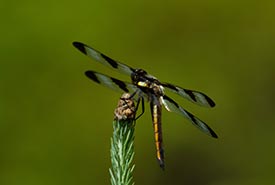
Dragonfly at Carden Alvar, ON (Photo by NCC)
There are an estimated 10 quintillion individual insects on Earth. That’s 19 zeroes after the one! Insects make up 75 per cent of all animals. Despite their ubiquity, they have a PR problem. People often find them gross, scary or even boring. And insects often end up in the news when they’re a nuisance to humans, despite the very small population of pest insects. In reality, insects keep nature balanced and play an important role in our food web. Without them, humans wouldn’t survive. That’s why we’re sharing five ways insects make our world a better place.
1. Insects pollinate plants
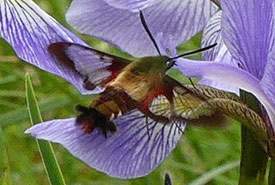
Hummingbird clearwing (Photo by Stuart Tingley, CC BY-NC 4.0)
While bees and butterflies get all the credit, moths, wasps, ants and beetles are also pollinators. Insects are integral to our food systems as one-third of food crops depends on the important work of pollinators. Insect pollination is the process in which plant pollen is distributed by insects. Plants often attract insects via nectar, bright colours, attractive shapes and patterns along with alluring scents to encourage them to transport pollen grains from one plant to another. In fact, plants and pollinators have mutually beneficial relationships because pollen and nectar are a food source for many insects.
2. Insects decompose waste and organic matter
Without insects, things would be pretty smelly and gross on planet Earth. Many different species take on the messy and unglamorous job of decomposing organic matter, like leaf litter, feces and animal carcasses. This supports new plant growth and ensures ecosystems receive a constant flow of nutrients.
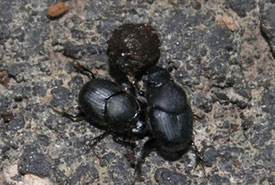
Scooped scarab (Photo by melissa_m79, CC BY-NC 4.0)
One hard-working decomposer is the dung beetle. With 7,000 known species across six continents, they make a pretty robust clean-up crew. Dung beetles should probably receive the employee of the month award year-round for their continued enthusiasm and hard work. By rolling, tunnelling and physically living in dung, they facilitate many ecological benefits. For example, dung beetles break up cow and sheep dung and tunnel it into the soil, providing plant roots with much-needed nutrients. They also help spread seeds in dung by burying them deep in the soil. This protects seeds from hungry animals and increases their chances for germination. Learn more about the wonderful work of dung beetles in this TED-Ed video.
3. Insects control pest populations
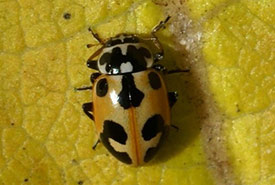
Parenthesis lady beetle (Photo by Christian Grenier)
Some insects are predators that hunt other insects. This helps keep populations in check, which in turn protects gardens and farm crops. Ladybugs, also known as lady beetles or ladybird beetles, have a voracious appetite for plant-eating insects, like aphids. Other beneficial predator insects include green lacewings, ground beetles, dragonflies, tachinid flies and parasitic wasps, among many, many others. Learn more about your insect garden allies and how to attract them.
4. Insects are an important food source
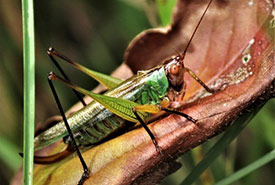
Black-legged meadow katydid (Photo by Bill Lucas, CC BY-NC 4.0)
Insects are an important food source for a variety of bird, mammal and reptile species. They’re also a staple in the diets of over a fourth of the world’s population (that’s two billion people!), and in some cultures, are a delicacy. Beetles are the most popular insect to eat; however, there are about 2,000 catalogued species that are edible. This includes caterpillars, crickets, grasshoppers, locusts and more. Insects have a high protein and fat content and require far less food to raise than birds and mammals. They can help meet the human demand for protein and have a much lower environmental impact than raising cattle and poultry.
5. Insects are inspiring
Despite a staggering number of insects threatened with extinction, they’re incredibly resilient arthropods. Many continue to adapt on certain levels to anthropogenic changes, like habitat loss, pesticides, warming climate and invasive species.
Insects can also inspire deeper connections to nature. Because they’re almost everywhere, they’re the perfect guide to the natural world. People can experience nature up close in our backyards, parks and communities through the lens of insects, especially for children given their natural curiosity.
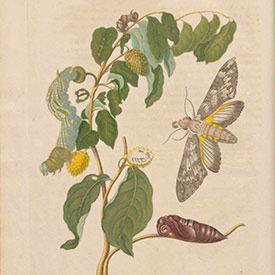
Maria Sibylla Merian, page from Metamorphosis-insectorum Surinamensium, 1705 (Public domain via Wikimedia Commons)
Insects have even inspired artists throughout the ages and were well documented during the naturalist and scientific boom of the 17th, 18th and 19th centuries. From scientific illustrations (Maria Sibylla Merian is known as the woman who made science beautiful) and museum entomology collections. to slow-motion videos and Instagram posts, the beauty and wonder of insects have been celebrated in many different ways.
Maria Sibylla Merian, page from Metamorphosis-insectorum Surinamensium, 1705, Public domain, via Wikimedia Commons
How can you help support insects?
1. Listen to our episode of "What the f*** is biodiversity?" about soil biodiversity with Dr. Valerie Behan-Pelletier and learn about the State of Knowledge on Soil Biodiversity.
2. Learn about what’s causing insect populations to decline along with the impact and solutions for light pollution.
3. Join the citizen science movement by sharing your insect observations on iNaturalist.
4. Learn how you can support native pollinators in your backyard garden or on your balcony.
This blog originally appeared on the National Environmental Treasure’s website and is reposted with permission.


